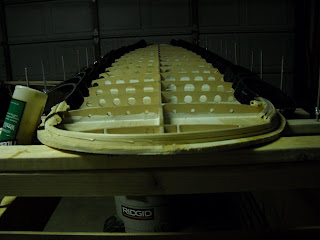




After a nearly three month respite, I'm back to building the Waterlog. When I left off, I had just completed adhering the chine log and one or two of the bead and cove strips. I've since glued about six or seven additional bead and cove strips and it's starting to look more like a surfboard. The PVC clamps come into their own just as the 2" clamps can longer get around the strips.
All was going well until I noticed that there are about three frames on the left hand side where the bead and cove strips are not quite in contact with the frames. There is probably a 1/16" gap at the middle frame, but less on the two contiguous frames. This is the case with only about two bead and cove strips, then there is continuous contact with all them. I'm concerned that section of the rail will not be "fair," which the directions ominously warn not to let happen. It did, and now I'm going to have to deal with it. I thought squeezing that section of the rail closer to the frames might work. I was able to squeeze it closer; unfortunately, I stressed the entire section of the rail doing so. Later, when I was wiggling the next bead and cove strip on that section of the rail, twelve inches of the rail lifted off the starter rail. Oops. I quickly re-glued that section and clamped it down. I'm going to have to try some other solution. Maybe sanding it "fair" when I'm shaping the rails will work. In the meantime, I'm wondering if I should reinforce that section from the interior sided of the rail. Perhaps with some addition Tite Bound.
I desperately need to pick up the pace of this project, as the leaves are falling and the temperatures are beginning to drop. I doubt that I should be glassing the board in the garage when it gets too cold. It has also been made clear that the cars get first priority in the garage as soon as the first snow arrives. Besides, I want to start surfing on this new water craft.
Above are a few pictures of the Waterlog as the bead and cove rails are being adhered. Sorry, no images of the rail section separating from the board.
Quick update...I emailed Mike L, explaining the gap issue and here's his response: If there are gaps, but you're already well above those points with your railing, just mix up some thickened epoxy with sawdust and smear it in the those areas on either side of the frame(s). The will just support the strips and keep the board a little stronger in those areas. If you are still railing, and some of the frames are pulled away enough where it is hard to keep the shape with the rail strips, you might cut some little shims from scrap cedar to push into the gap. This will give the strips something to land on i those areas. Little by little, you want to come back to the frames so that the get gap gets progressively smaller. This is the best way to keep the rail shape as true as possible.
I'm going to use the epoxy and saw dust solution, as the gaps aren't very large. Within two bead and cove strips, they're laying nicely on the frames again. I don't think this will be a huge issue in the long run.
Quick update...I emailed Mike L, explaining the gap issue and here's his response: If there are gaps, but you're already well above those points with your railing, just mix up some thickened epoxy with sawdust and smear it in the those areas on either side of the frame(s). The will just support the strips and keep the board a little stronger in those areas. If you are still railing, and some of the frames are pulled away enough where it is hard to keep the shape with the rail strips, you might cut some little shims from scrap cedar to push into the gap. This will give the strips something to land on i those areas. Little by little, you want to come back to the frames so that the get gap gets progressively smaller. This is the best way to keep the rail shape as true as possible.
I'm going to use the epoxy and saw dust solution, as the gaps aren't very large. Within two bead and cove strips, they're laying nicely on the frames again. I don't think this will be a huge issue in the long run.

















